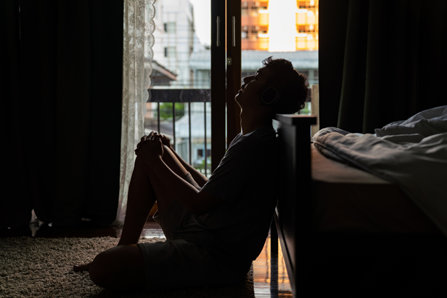New Study Shows Lockdowns Associated with Binge Drinking

A recent study predicted how much binge drinking increased for every additional week that people spent in lockdown. The data suggested that, while a lockdown may be beneficial for public health outcomes, lockdowns do present risks to behavioral health as well.
Public health lockdowns are mandatory health measures taken in a county, city, state, or nation to protect the populace from health risk. Though not common, lockdowns are used during medical crises to prevent the spread of viral pathogens, as in the COVID-19 pandemic. While it may be necessary to implement a stay-at-home order to slow the spread of COVID-19, it is just as important for public health officials and individual households to consider the potentially harmful effects of such a lockdown.
What is Binge Drinking?
The National Institute on Alcohol Abuse and Alcoholism defines binge drinking as “A pattern of drinking alcohol that brings blood alcohol concentration (BAC) to 0.08 percent – or 0.08 grams of alcohol per deciliter – or higher. For a typical adult, this pattern corresponds to consuming 5 or more drinks (male), or 4 or more drinks (female), in about 2 hours.”
Binge drinking is a serious public health problem. According to the Centers for Disease Control and Prevention, binge drinking is the most common and most serious pattern of excessive alcohol use in the United States. One in six U.S. adults binge drinks about four times per month, consuming about seven drinks per binge. That results in 17 billion total binge drinks consumed by U.S. adults annually, or approximately 467 binge drinks per binge drinker. Some of the serious risks associated with binge drinking include:
- Unintentional injuries (car crashes, falls, burns, alcohol poisonings).
- Violence (homicide, suicide, intimate partner violence, sexual assault).
- Sexually transmitted infections.
- Unintended pregnancies.
- Fetal alcohol spectrum disorders (FAS).
- Sudden infant death syndrome.
- Chronic diseases (high blood pressure, stroke, heart disease, liver disease).
- Cancers (breast, mouth, throat, esophagus, liver, and colon).
- Memory and learning problems, cognitive difficulties.
Binge Drinking Statistics Rose During Lockdown

An August 2020 study published in the American Journal of Drug and Alcohol Abuse examined various stressors introduced by the COVID-19 pandemic and the public health response to it. The study sought to investigate how binge drinking trends changed from mid-March 2020 to mid-April 2020, the first month of the shelter-in-place orders.
The findings were concerning. Of the 1,982 participants surveyed, 34% admitted to binge drinking during the first month of shelter-in-place orders, a percentage starkly higher than the NIAAA’s assessment that approximately 25.8% of the U.S. population binge drinks (a pre-pandemic assessment).
The researchers further determined that of people who already binge drank pre-lockdown, 60% of binge drinkers increased their binge drinking during the first lockdown. And of the people surveyed who did not binge drink pre-lockdown, 28% began binge drinking during the lockdown.
The longer the lockdown went on, the greater the odds of binge drinking. For every one-week increase in time spent at home, there was a 1.19 greater chance of binge drinking.
Study authors Weerakoon, Jetelina, and Knell summarized their findings with a warning for the future, “The findings of this study indicate that COVID-19 stressors are related to alcohol consumption and binge drinking among adults residing in the U.S. This highlights the need to consider the ancillary and potentially unintended health effects of the COVID-19 pandemic, which could have long-lasting population health consequences. Future research should aim to adapt and implement innovative efforts to mitigate binge drinking, and other potential negative health behaviors, while adults are isolated at home.”
Binge Drinking a Predictor for Alcohol Addiction
Binge drinking is a harmful activity that increases one’s risk for alcohol addiction. That is especially true for young adults, but anyone of any age creates a risk for alcohol addiction when they binge drink.
As discussed earlier, binge drinking presents a long list of risks and harm, all on its own. And on top of the danger that people expose themselves to when they binge drink, there is the underlying risk that they may fall down a dwindling spiral of alcohol misuse that eventually leads to addiction.
The Importance of Properly Managing a Lockdown
As behavioral, emotional, spiritual, and psychological health of individuals and families is strained during COVID-19-related lockdowns, it is important that a lockdown is properly managed and that families and households have resources to stay safe and healthy during such challenging times.
Public health experts and policymakers must consider the risks and stressors of a stay-at-home order. It’s of the utmost importance that families, individuals, workforce members, students, and the elderly all have resources to protect their mental and behavioral health while being made to stay at home. If this is not done, the COVID-19 pandemic may be brought under control yes, but other public health issues will increase.
Ideas for How to Cope with the Stress of Staying at Home

There are healthy ways of coping:
- Engage in at-home exercise. A way to release endorphins and take care of the body, home exercise is an excellent strategy for combating unpleasant thoughts or feelings about being cooped up at home for days on end.
- Find a hobby. Doing something constructive and interesting that one can work at for hours is an excellent way to cope with shelter-in-place measures.
- Learn something new. Books, documentaries, and online classes are available during a lockdown, allowing an individual to expand their mind and learn a new skill, discover a new subject, or improve themselves in an area that they’d like to work on.
- Spend time with the family. Most families must shelter in place together, which gives families a rare opportunity to bond and get to know each other better.
- Do projects around the house or yard. A shelter-in-place order is a great time to perform repairs or improvements on the home, enhance landscaping and outdoor spaces, or generally tidy up.
One could argue that protecting the populace from the dangers of addiction is just as important as safeguarding physical health. Given that it is now a known fact that COVID-19 lockdowns create behavioral health risks, in the future, families, health experts, planners, and policymakers must take into account these risks in order to plan for shelter-in-place measures that might best mitigate those risks.
Sources:
- https://www.niaaa.nih.gov/alcohol-health/overview-alcohol-consumption/moderate-binge-drinking
- https://www.cdc.gov/alcohol/fact-sheets/binge-drinking.htm
- https://doi.org/10.1080/00952990.2020.1832508
- https://www.niaaa.nih.gov/publications/brochures-and-fact-sheets/alcohol-facts-and-statistics
- https://bmjopen.bmj.com/content/9/5/e026375


 ®
®